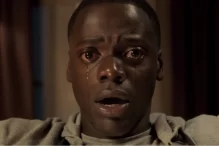The premise of Get Out has been done before: A young black man (Daniel Kaluuya) goes home with his white girlfriend (Allison Williams) to meet her parents. You can pretty much fill in the blanks from there.
Except, gloriously, you can’t. Get Out — written and directed by Jordan Peele, half of the celebrated comedy duo Key and Peele — makes the incredibly smart move to cast this story about racism not as a drama or comedy, but as a horror film.
Racism is scary, of course. But Get Out isn’t about the blatantly, obviously scary kind of racism — burning crosses and lynchings and snarling hate. Instead, it’s interested in showing how racist behavior that tries to be aggressively unscary is just as horrifying, and in making us feel that horror, in a visceral, bodily way. In the tradition of the best social thrillers, Get Out takes a topic that is often approached cerebrally — casual racism — and turns it into something you feel in your tummy. And it does it with a wicked sense of humor.
Get Out is about a black man who stumbles into a very white, very weird world
After dating for about five months, Chris (Kaluuya) and Rose (Williams) are headed upstate to hang out with her aggressively white parents, neurosurgeon Dean (Bradley Whitford) and therapist/hypnotist mother Missy (Catherine Keener). Chris is a little worried about Rose’s family’s reaction to him — she hasn’t told them that her boyfriend is black — but they’re very nice to him, even if Dean’s pointedly enthusiastic comments about the achievements of Olympian Jesse Owens and loving Obama come off as a bit clueless.
The estate is tended by a groundskeeper named Walter (Marcus Henderson) and a housekeeper named Georgina (Betty Gabriel), both of whom are black. Dean apologizes to Chris about the optics of two black servants at a white family’s estate seeming a bit regressive. Rose’s brother Jeremy (Caleb Landry Jones) also turns up, to get drunk and tell embarrassing stories about his sister. Things settle into a normal family routine. Everyone’s excited for an upcoming annual party to which all the family friends are invited.
Then things start to get weird. Chris, a habitual smoker, can’t sleep the first night and steps outside to have a cigarette. He sees some odd activity on the premises, and when he comes inside, he has a strange encounter with Missy. When he wakes up the next morning in a cold sweat, things still seem … off. Later, when he tries to call his buddy Rod (Lil Rel Howery), a TSA agent, he discovers his cellphone has been randomly unplugged and now has no power. And at the party, the only other black guy, Logan (Lakeith Stanfield), is acting really weird.
The less you know about where Get Out goes from there, the better. The element of surprise is what makes the movie fun to watch, and the cathartic third act had the audience I saw the film with hollering at the screen and applauding.
Get Out draws on the visceral experience of being objectified or colonized by another consciousness
From the beginning of the film, Peele’s directorial vision is clear: creepy, funny, totally contemporary and aware of what it’s doing. The movie vacillates between shots that belong to comedy — conventional over-the-shoulder shots that let you feel like you’re in on the conversational joke — and shots that belong to horror — empty patches of screen that make you feel like someone could jump out at any moment. It’s a remarkably assured and confident debut from Peele, and perfectly cast.
It’s clear that Peele is drawing on a long tradition of social thrillers and horror films. In fact, he recently curated a series of them at the Brooklyn Academy of Music to coincide with the release of Get Out, and the films he picked are revealing. Among them are Night of the Living Dead, Funny Games, The Silence of the Lambs, The Shining, and the film I couldn’t stop thinking about while watching this one: Rosemary’s Baby.
Most of these films draw on a very particular terror: the feeling of having your personal space or your own body invaded by some other consciousness, usually one with malicious intent. That can take the shape of home invasion (Funny Games), or slowly going nuts (The Shining), or zombification (Night of the Living Dead), or being literally consumed by someone else (The Silence of the Lambs).
Rosemary’s Baby holds a particularly visceral spot in horror film history for women, as it draws on the complicated feeling of having another being in your body during pregnancy, as well as being seen as an object, a body to be remarked upon and talked about. (That’s hardly a phenomenon experienced only by pregnant women, of course.)
The feeling of being turned into an object to be feared, desired, or operated upon is also part of Get Out, though in this case it’s positioned in terms of the black body, particularly the body of a black man. Nice white people talk to him and about him in ways that make it clear he’s not like them — whether it’s about his “frame” and “genetic makeup” or about black skin “being in fashion” or asking Rose if it’s true that “it” is better. (We know what that person means, and so do Rose and Chris.)
Chris endures it all with a smile that seems born of years of having to put up with this kind of thing, and we’re allowed in on the joke. These clueless white people are trying to be cool in front of Chris, whom they just sort of think must be cool because he’s black, and he’s indulged it. He wears the same expression when he and Rose talk to a cop after they accidentally hit a deer on their way up north, and the policeman who responds to their call insists on seeing Chris’s ID — something Rose soundly rebuffs in words that would get Chris hauled away in the back of the cop car (though her act takes on a different meaning later in the movie).
Get Out is a movie about double consciousness, and it pulls off its goal with skill
In the film’s final act, the racism subtext becomes text in a big way, which reveals what Get Out was after all along. The film taps into the phenomenon of double consciousness, which W.E.B. Du Bois wrote about in an essay that appeared in his 1903 book The Souls of Black Folk.
In the essay, Du Bois identified the feeling of having an identity that’s been splintered into several parts — of “always looking at one’s self through the eyes of others, of measuring one’s soul by the tale of a world that looks on in amused contempt and pity.” He continues:
One ever feels his two-ness, — an American, a Negro; two souls, two thoughts, two unreconciled strivings; two warring ideals in one dark body, whose dogged strength alone keeps it from being torn asunder.
The history of the American Negro is the history of this strife — this longing to attain self-conscious manhood, to merge his double self into a better and truer self. In this merging he wishes neither of the older selves to be lost. He does not wish to Africanize America, for America has too much to teach the world and Africa. He wouldn’t bleach his Negro blood in a flood of white Americanism, for he knows that Negro blood has a message for the world. He simply wishes to make it possible for a man to be both a Negro and an American without being cursed and spit upon by his fellows, without having the doors of opportunity closed roughly in his face.
Since Du Bois, the idea has been adapted by women, especially black feminists writing about living in patriarchal societies. Chris’s experience embodies a 2017 version of Du Bois’s, both in how he experiences his two-ness among the folks upstate and how he relates to Walter and Georgina.
(The film itself seems a bit doubly conscious, though in a different way; it both embodies and winks at some of the tropes common to horror films, which obviously signal that everything isn’t going to be hunky-dory at Rose’s parents’ house. After all, it’s titled Get Out. You kind of know what’s coming.)
The experience of being observed matters here, and the manner in which one is observed and becomes the object of desire — a sort of fetish object — is at the center of Get Out, even though it doesn’t call attention to the idea specifically.
















+ There are no comments
Add yours